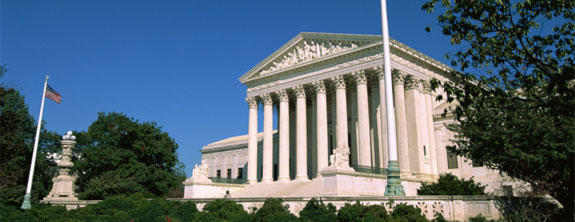
The phrasing in the First Amendment to the U.S Constitution intends to guarantee the right of free speech and the right to peaceably assemble to redress grievances. The Supreme Court just decided that campaign finance laws that limit contributions to candidates limit free speech. In this case known as McCutcheon v. FEC it might be an example of the justices changing the subject to justify a personal agenda rather than application of a constitutional principle like free speech. Before you decide how you think read below and compare the case known as Truax v. Corrigan (257 U.S. 312).
The case of Truax versus Corrigan resulted from a strike of employees at a restaurant in Bisbee Arizona. Strikers picketed, displayed banners and passed out brochures condemning the restaurant as unfair to unions and encouraging customers to boycott. Revenues dropped 50 percent as a result of union résistance. The restaurant filed for an injunction to end picketing as a cause of irreparable harm to the restaurant. Restaurant attorneys claimed the union could not rely on the recently enacted Arizona law that forbid restraining orders and injunctions in a labor dispute. They claimed the Arizona law violated 14th amendment rights against the taking of property without due process of law and denied them equal protection of the law.
The state court dismissed the case and the Arizona Supreme Court concurred citing the state law. The case moved to the U.S. Supreme Court, where the majority opinion written by Chief Justice William Howard Taft reversed the Arizona courts.
The Taft opinion declared “plaintiff’s business is a property right” protected from injury caused by the striker’s picketing. Pickets induced willing patrons to leave “by having agents of the union walk forward and back in front of plaintiff’s restaurant . . .” and by having agents at the restaurant “during all business hours” to “continuously announce in a loud voice, audible for a great distance, that the restaurant was unfair to the labor union.” Willing and would-be patrons were asked “Can you patronize such a place and look the world in the face?” and told “All ye who enter here leave all hope behind” and “Don’t be a traitor to humanity.”
Justice Taft characterized the picketing as a “campaign” of “unlawful annoyance and a hurtful nuisance in respect of the free access to the plaintiffs’ place of business” that “was compelling every customer or would be customer to run the gauntlet of most uncomfortable publicity, aggressive and annoying importunity, libelous attacks, and fear of injurious consequences, illegally inflicted, to his reputation and standing in the community.”
After declaring union picketing an unlawful conspiracy, Justice Taft and the majority declared the Arizona law forbidding injunctions in labor disputes to be an unconstitutional “subordination of fundamental principles of right and justice.” If “a wrongful and highly injurious invasion of property rights,” allowed by the Arizona Supreme Court is “practically sanctioned” by the U.S. Supreme Court, then the owner will be “stripped of all real remedy,” which is “wholly at variance” with the principle against taking property without due process of law in the 14th amendment.
Further, the majority declared the Arizona law denied the restaurant owner the 14th amendment guarantee of equal protection of the law. Instead the majority declared the law created class privilege for unions because a violation of property rights from picketing would be subject to injunction under Arizona law, “except when committed by ex-employees of the injured person.”
Justice Oliver Holmes wrote a blunt dissent for the court minority who recognized the majority opinion depended entirely from defining business as a “thing” with property rights. “By calling a business ‘property’ you make it seem like land, and lead up to the conclusion that a statute cannot substantially cut down the advantages of ownership existing before the statute was passed.” . . . Business “is a course of conduct and like other conduct is subject to substantial modification according to time and circumstances both in itself and in regard to what shall justify doing it harm.” Justice Holmes added “There is nothing that I more deprecate than the use of the Fourteenth Amendment beyond the absolute compulsion of its words to prevent the making of social experiments that an important part of the community desires . . .”
In Truax v. Corrigan the court changed the subject from the right to picket as an expression of free speech and free assembly to a violation of property rights and due process. Pickets that block streets, break windows or destroy property can be arrested, but not as pickets, as criminals committing misdemeanor crimes. Pickets that assemble on public property to protest and redress grievances are engaged in one of the most fundamental rights of democracy, except that William Howard Taft, lawyer, federal judge, president of the United States, Yale University law professor and Chief Justice of the United States Supreme Court would not recognize his opinion as a grant of protection and privilege to the well-to-do and the upper class.
In McCutcheon v. FEC the majority of the court changed the subject from bribery to free speech. The majority acknowledges the bribery issue, but defines it away by demanding bribery be a proven transaction with thorough evidence of an exchange of money for political favors, whereas Congress and many others notice how wealthy corporate campaign contributions correlate with political favors.
Picketing is the poor man’s avenue to free speech; inexpensive and equally available to all. When free speech was a disadvantage to the well to do the Supreme Court made it an unconstitutional interference with property rights. Now that limits on campaign contributions are a disadvantage to the well to do the Supreme Court makes these limits an unconstitutional interference with free speech.
Heads I win, tails you lose. Think of that as judicial precedent at the U.S. Supreme Court.
 About the author: Fred Siegmund covers America's jobs as part of work doing labor market analysis and projections for a client base of recruiters, trainers and counselors. Visit him at www.americanjobmarket.blogspot.com
About the author: Fred Siegmund covers America's jobs as part of work doing labor market analysis and projections for a client base of recruiters, trainers and counselors. Visit him at www.americanjobmarket.blogspot.com



